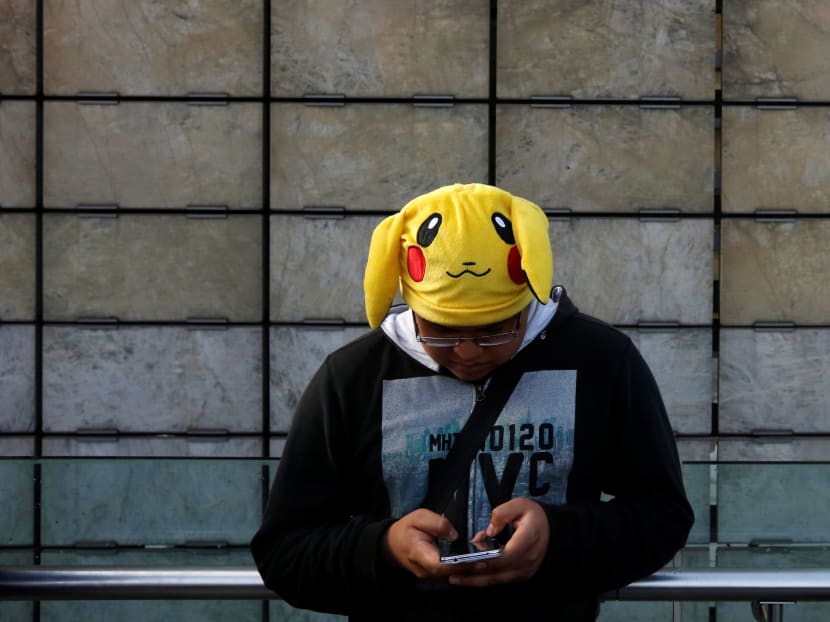Pokemon Go: The inevitable cooling of mobile’s hottest property
LOS ANGELES — Pokemon Go, the augmented-reality game that lunged out of the gate in a monstrous burst this summer, has fallen back to Earth.

A man wearing a Pikachu hat, a character from Pokemon, plays Pokemon Go during a gathering to celebrate "Pokemon Day" in Mexico City, Mexico on Aug 21, 2016. Photo: Reuters
LOS ANGELES — Pokemon Go, the augmented-reality game that lunged out of the gate in a monstrous burst this summer, has fallen back to Earth.
The mobile game from Niantic Labs, which lets users catch virtual demons that appear in the area around them, became the most popular game app in US history just one week after it was released in July.
However, while Pokemon Go remains the most-used mobile game for now, its weekly active user base has dropped from a peak of about 40 million shortly after launch — to less than 15 million by mid-October, data from research firm SurveyMonkey Intelligence shows. The firm collects data from an opt-in panel of over 1.5 million iOS and Android smartphone users in the US.
In addition, individual users are on average playing the game less than they did during Pokemon Go’s first month of release. In July, about 68 per cent of all daily users were spending more than 3 minutes per day in the game, according to research firm Sensor Tower. So far in October, that number has dropped to 56 per cent.
“This isn’t a massive decrease, but still indicates that players are less engaged in the absence of substantial new content being added to the game since launch,” said Mr Randy Nelson, head of mobile insights at Sensor Tower.
In a bid to boost usage, Niantic this week is launching a special Halloween promo for Pokemon Go: From Oct 26 to Nov 1, users will earn double the amount of candy every time they catch, hatch and transfer monsters, and select Pokemon will appear more frequently.
There’s other evidence that Pokemon Go’s momentum has slowed in the last few months. On Sept 20, it was knocked off its perch as the top-grossing app in Apple’s US app store after a 74-day run at No 1. As of Monday morning (Oct 24), it held the No 8 position on Apple’s App Store ranking of top-grossing games in the States — after games Clash Royale, Mobile Strike, Game of War - Fire Age, Clash of Clans, and Candy Crush Saga as well as Pandora and Netflix — and it has fallen to No 71 overall among all free apps.
On US smartphones, since the end of September Pokemon Go downloads have fallen closer to the level of longstanding top game titles like Words With Friends, Clash of Clans and Candy Crush, according to SurveyMonkey Intelligence.
But analysts say there’s no reason for panic at Niantic, which spun off from Google last year and is now backed by Google, the Pokemon Company and Nintendo. Instead, the bell-shaped curve of of the game’s usage and download performance is par for the course.
“Pokemon Go isn’t having a player-retention crisis,” said SurveyMonkey’s Michael Sonders. “In fact, in terms of how well it’s keeping its users, it’s performing very much like a typical top mobile game.” For example, Clash of Clans, with about 3.85 million weekly active users in the US, has a weekly retention rate of 75 per cent (meaning 25 per cent of its users don’t come back the following week). Pokemon Go has the same 75 per cent retention rate, but with a larger user base.
But the current state of Pokemon Go is quite a contrast from where the property was just a few months ago. Pokemon Go generated more than US$600 million (S$836.2 million) in revenue through the end of September, setting a record as the fastest mobile game to hit that figure, according to market-research firm App Annie.
In early September, Niantic said Pokemon Go had been downloaded more than 500 million times in more than 100 countries worldwide. Sensor Tower put the total number of Pokemon Go downloads for the third quarter of 2016 at closer to 200 million (speculating that Niantic’s number was higher because it included multiple install per Apple or Google account across multiple devices). But that still makes it easily the most-downloaded app overall worldwide in Q3 — more than double the total installs of the next two biggest apps, Instagram and Snapchat, according to Sensor Tower.
Initially, Pokemon Go’s massive popularity led to frenzied speculation that it could generate upwards of US$3 billion in revenue for Apple alone and spurred Legendary Entertainment to acquire rights to make a live-action Pokemon movie. Last month Nintendo, looking to cash in on the craze, began selling a wristwatch-style device for the game that costs US$35.
The current data suggests Pokemon Go’s virtual monsters still have plenty of legs left — but that they’ll be running closer to industry norms. VARIETY.COM/REUTERS





